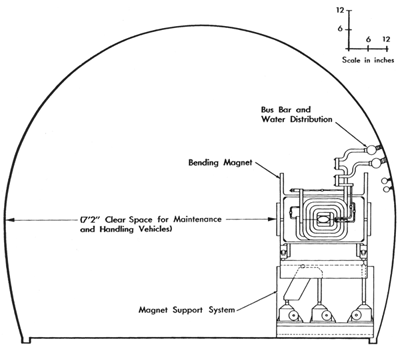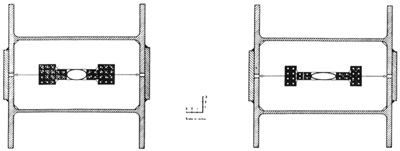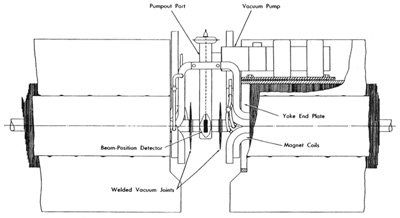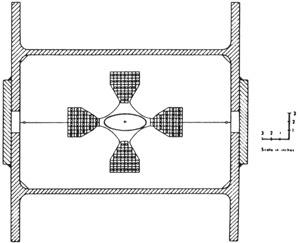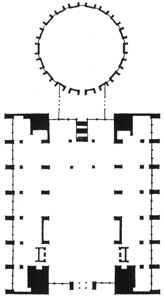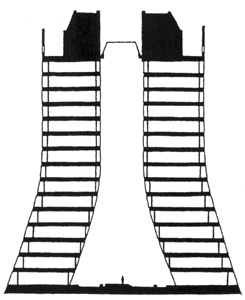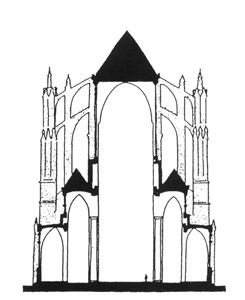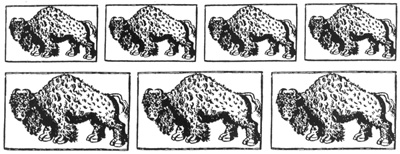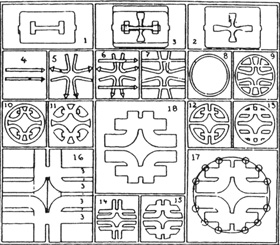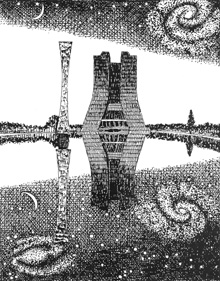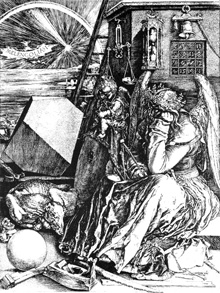"Golden Books" - Starting Fermilab
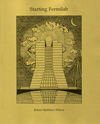 |
Starting Fermilab Robert Rathbun Wilson |
 |
 |
![]()
Fermi National Accelerator Laboratory
Batavia, Illinois
Operated by Universities Research Association, Inc.
Under Contract with the United States Department of Energy
Introduction
 Robert R. Wilson, Fermilab's founding director from 1967-78, defined Illinois' high-energy physics center in a style and manner quite distinctly his own. Born in Frontier, Wyoming in 1914, Wilson responded to his western training ground as a curious investigator and observer. He received his formal education in the forefront laboratories of Berkeley and Princeton, leading to his recruitment for research involvement in Los Alamos, where he served as leader of the cyclotron group and head of the experimental nuclear physics division, and also mayor of the town. Following a brief period at Harvard, Wilson went to Cornell where his mastery of experimental elementary particle physics and accelerator design was demonstrated in the successful projects of the Newman Laboratory of Nuclear Studies.
Robert R. Wilson, Fermilab's founding director from 1967-78, defined Illinois' high-energy physics center in a style and manner quite distinctly his own. Born in Frontier, Wyoming in 1914, Wilson responded to his western training ground as a curious investigator and observer. He received his formal education in the forefront laboratories of Berkeley and Princeton, leading to his recruitment for research involvement in Los Alamos, where he served as leader of the cyclotron group and head of the experimental nuclear physics division, and also mayor of the town. Following a brief period at Harvard, Wilson went to Cornell where his mastery of experimental elementary particle physics and accelerator design was demonstrated in the successful projects of the Newman Laboratory of Nuclear Studies.
Wilson, known for his maverick approach in solving problems, also brought his specific sensitivity and aesthetic awareness, as well as visionary care for the environment, to his frontier Laboratory on the prairie. "Starting Fermilab: Some Personal Viewpoints of a Laboratory Director (1967-1978)" was written by Wilson for the 1987 Fermilab Annual Report to capture his memories on the occasion of Fermilab's twentieth anniversary. With characteristic poetic allusions he tells the story of the efforts of the many people dedicated to the achievement of this 20th century experiment in creativity for the pursuit of knowledge. It is a tale from times gone by, yet one which is still relevant as the Laboratory evolves for the nation's future needs.
Starting Fermilab
 "When to the sessions of sweet silent thought
"When to the sessions of sweet silent thought
I summon up remembrance of things past..."
It wasn't the taste of the madeleine soaked in tea which evoked these memories of things past, but rather the request of Leon Lederman to help mark the twentieth anniversary of Fermilab. Ah, memories, how conveniently we forget the disagreeable, how adeptly we rearrange the actuality, how warm and pleasant it all becomes -- in memory! My coverage will be incomplete and very personal -- a stream-of-conscious view of starting Fermilab.
I shan't dwell on how it happened that a proton synchrotron designed at the University of California, Berkeley (UCB), to give 200 BeV came to be built in Illinois instead of in California and how I, then a carefree professor at Cornell University, was chosen faute de mieux to head the construction of what eventually would be named Fermi National Accelerator Laboratory. I shall also gently elide my first months in an unreal world in which I was the lone employee, wondering who, if anyone, would come to help me turn that cornfield into a physics laboratory. Eventually, brave physicists and engineers did come, but the hiatus gave me time to meditate about and discuss with others the kind of laboratory I hoped it would become.
The result of my meditations was that the designed proton energy, 200 GeV, was too small for the physics opportunities, too small for the size of the site, and too small for the amount of money available. I also felt that the best technical people would come (and I hope this was panache and not hubris), only if challenged by something hard to do. Accordingly, I announced that 400, or even 500, GeV would be our goal. That worked. All sorts of superb people identified themselves as eager to do just that. Similarly, I let it be known that we would try to return to the same number of experimental facilities as had been originally designed and to the full intensity of proton current -- not that of the "reduced scope." And so that no one could charge me with "not being crazy enough," I put the UCB construction schedule of about seven years ahead to about five years.
The powers-that-be in the Atomic Energy Commission looked benignly on all this madness, but pointed out that I had signed in blood not to exceed the authorized level of $250 million as "reduced" from the UCB budget of $340 million, and that I would rot in Hell if I did. Nevertheless, from Glenn Seaborg, the AEC Head Commissioner, on, the AEC functionaries were romantics at heart. Without their enthusiasm and commitment and more-than-willing cooperation, nothing would have happened. The enthusiasm of the congressmen and senators in the Joint Committee for Atomic Energy (JCAE) was unexpected and also a vital ingredient in how we fared.
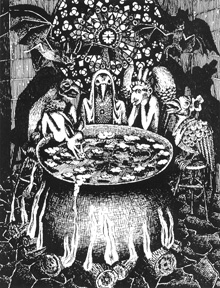 I seemed to have a boss in every direction, not only the AEC and the JCAE, but more directly: the Universities Research Association and the physics community itself. Harry Smyth, one of my early mentors, was Chairman of the URA Board of Trustees. A "typical" member of the Board was that eminence gris, Leon Lederman, who had had the original vision of a "truly national laboratory" built and operated for and by all of the particle physics people, where they would be "at home and loved." Well, they all helped, but it was Norman Ramsey, President of URA, who throughout my tenure as Director was my greatest source of strength. We complemented each other in many ways. Norman has a quick and logical mind, and in our frequent discussions about all aspects of the Laboratory, my ideas, largely intuitive, were tested against his good sense -- and not infrequently abandoned. We had been friends before, but our friendship deepened in the adventure of Fermilab.
I seemed to have a boss in every direction, not only the AEC and the JCAE, but more directly: the Universities Research Association and the physics community itself. Harry Smyth, one of my early mentors, was Chairman of the URA Board of Trustees. A "typical" member of the Board was that eminence gris, Leon Lederman, who had had the original vision of a "truly national laboratory" built and operated for and by all of the particle physics people, where they would be "at home and loved." Well, they all helped, but it was Norman Ramsey, President of URA, who throughout my tenure as Director was my greatest source of strength. We complemented each other in many ways. Norman has a quick and logical mind, and in our frequent discussions about all aspects of the Laboratory, my ideas, largely intuitive, were tested against his good sense -- and not infrequently abandoned. We had been friends before, but our friendship deepened in the adventure of Fermilab.
How does one gather an instant administration and staff? That was an even more severe problem than re-designing the accelerator, but of course the problems were coupled. Bringing a staff of physicists and engineers together was straightforward; one tried for the best. But my fellow administrators would be different in that they had to be loyal to me and to my commitment, yet I needed independent minds to supplement my own talents and to keep me from making unwise decisions and policies. One couldn't just try somebody and then, if things did not work out, look for someone else; for one thing, there wasn't enough time for that, and for another, to get a good person required a commitment -- like a marriage.
My most critical need was for a deputy director and I chose Ned Goldwasser, not only for his obvious competence, but because he supplemented my own experience. Then, too, anyone who knows Ned would know that he would be very strong in any disagreement, certainly no "yes" man. Ned was a godsend. Indefatigable, warmhearted, sophisticated, there was no job that needed doing that he would not and did not tackle. He was particularly active with the physics programs and relations with our user physicists, but every facet of the Lab came into his purview -- especially problems involving sensitivity and humanness. What a lucky day for me, and the Lab, when early on he signed up.1
Those early meditations of mine were often a kind of a fantasy in which I envisaged the Laboratory as a utopian place where physicists coming from all parts of the country -- and from all countries -- would be doing their creative thing in an ambiance of well-functioning and yet beautiful instruments, structures, and surroundings that would reflect the aesthetic magnificence of their discoveries and theories. All this to be done in a scientific climate of mutual respect and responsibility; it would be a place where, according to the Chinese ideal, "All would be happy to do what they had to do, and would have to do what they were happy to do."
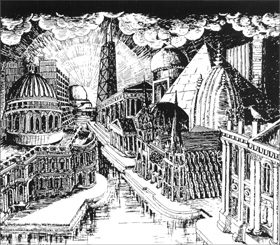
My fantasy of a utopian laboratory clearly required a setting of environmental beauty, of architectural grandeur, of cultural splendor, but therein lay the rub: money. A rule of thumb of large technical projects is that about half the costs go to technical things and the other half to conventional construction such as buildings, utilities, roads, and site development. This rule seemed to hold for the carefully-made cost analysis of the UCB study for the 200-BeV project. Roughly speaking, if we were to build to twice the energy, and hold to the reduced-scope budget of $250 million, would anything be left over for the architectural costs? Put differently, the conventional construction might be little affected by the reduction in scope of the project and hence might cost half of the UCB $340 million, leaving about $80 million for the accelerator. My conclusion from this was that I had better pay close attention to the architecture of the project for I was determined that it be significant, yet affordable. 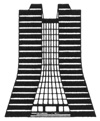 When I announced my ambitions for architectural significance to my scientific friends, some of them became angry with me, for they correctly reasoned that each dollar going to architecture would not go into physics.My justification was that if we produced a dowdy site with shabby buildings, then the technical people we wanted to work with us would not come and the statesmen, who might judge us in part by appearances, would not, in the long run, give us the funds we would need for our physics. There were other serious problems, a gathering storm of civil rights for one.2
When I announced my ambitions for architectural significance to my scientific friends, some of them became angry with me, for they correctly reasoned that each dollar going to architecture would not go into physics.My justification was that if we produced a dowdy site with shabby buildings, then the technical people we wanted to work with us would not come and the statesmen, who might judge us in part by appearances, would not, in the long run, give us the funds we would need for our physics. There were other serious problems, a gathering storm of civil rights for one.2
Let us take the beginning of the Lab to be June 15, 1967, when a small group of determined people showed up at the Executive Plaza Office Building at Oak Brook, Illinois. We occupied the vacant floor at the top, and were soon busily marking out on the unpartitioned floor where we would work until we had access to the site about two years later on. A pretty good plan evolved more or less by chance: There was a large, central, common area (the Bull Pit) and all around offices at the windows opened into it. A spontaneous discussion would start at about 8:00 a.m. and continue until about 6:00 p.m. One could choose to join the general debate, or retreat to an office for reflection and calculation. Every so often, I would ask a secretary3 to ring a school bell to announce that a decision on some particular facet of the project would be made. The drama of the situation just then was that we really had to race in order to qualify for funds for FY69 (at that time the federal year extended from July 1968 through June 1969). This meant that we had to re-design the whole project for the new site and for our new goals, and this full authorization report had to be done by October 1967. Otherwise we would lose at least a year.
Rather than just go for it, we decided to invest a month in floundering around, looking at all kinds of alternatives such as superconducting magnets (the technology wasn't ready yet) or colliding beams (again, not within either our reach or grasp). We hoped for an important invention. All sorts of people came by to participate in the excitement, and all sorts of ideas were explored. The Berkeley people were especially generous in explaining what had gone into the UCB report and why. I thought the most promising idea was that being championed by Gordon Danby, from Brookhaven, for a separate function lattice for the Main Ring magnet. In this rather old idea, the bending magnets would have a uniform magnetic field, meaning that they would go into saturation gracefully, and the separate focusing magnets would be pure quadrupoles. In the UCB design the bending and focusing magnets were combined by appropriate shaping of the magnet poles.
It was a good time for us to size each other up. At the end of the month (we had all been staying at a local Oak Brook motel and we varied in number between 10 and 100), 1 found myself on an airplane back to Ithaca, New York, reviewing all that had gone on in the preceding month. A number of design considerations fell into place, for example, the radius of the accelerator ring would be exactly 1 km (I have a propensity for round numbers that are hard to forget) and we would adopt the separated function lattice. The trouble with that was in Danby's bending magnets, which I thought were much too huge. They were a "window frame" design with all the coils uniformly distributed in the gap between the poles of the magnets. This implied a width of about 1 m. Before the airplane had come down, a new kind of magnet occurred to me in which some of the coil was put in the magnet gap and some of the coil was consolidated in a larger opening outside the gap. This implied a better aspect ratio of the width and height of the magnet which made it about half as big. That was perhaps my only real invention of the whole project, yet I was proud of it, for the Main Ring magnets were the single most expensive item. An incidental feature of this design was that the magnets, because of the compensation of an edge effect and a magnetic-potential drop, would be able to reach a field of 22.5 kg (compared with the 15 kg of the UCB magnets) and that meant we might reach the fantasy goal of 500-GeV protons. Other results of the design month were decisions to use a small tunnel to eliminate elaborate magnet supports going down 100 ft to bedrock, and to use solid-state rectifiers rather than the ubiquitous and fallible and expensive rotating generators in general use then.
My main concern was to get a complete laboratory in business at the earliest time, that is, one doing experiments. This meant that the accelerator, the experimental areas, and the experiments themselves should all be planned together. In some measure that's what we did. But obviously, it was the accelerator that would need the greatest emphasis. Without it in actual operation, the experimenters would find it difficult to make their plans -- their commitments. I didn't want time and money to be wasted by an over-design of the machine, yet it had to work, and work reliably, or we would be nowhere. I felt that inevitably we would make mistakes and part of my compulsion to proceed rapidly was so that we could recognize those mistakes and have the time to correct them.
The first accelerator in the chain of accelerators would be a 200-MeV linac. Its progress would be important in achieving a fast pace. We decided to copy a linac then being built at Brookhaven; it was well designed and we hoped to save time, effort, and money by just duplicating their orders.
In the summer of 1968, we managed to get possession of a few houses in the little town of Weston, which was on the site. A gung-ho group4 had been gathered to build the Linac and they eagerly moved in, announcing their presence in the wilderness with a sign, Fort Fortitude, from which, ominously, a real arrow protruded. The URA put up its own money so we could erect a temporary building adjoining and connecting the houses (it's still there, as are several other such buildings). By January 1969, the group had accelerated a beam of 60-KeV protons using parts largely borrowed from the Argonne National Laboratory, and were furiously designing and building the first 10-MeV section, the most complicated and critical part of the 200-MeV Linac. By dint of a heroic push, which involved even secretaries and AEC personnel doing such things as wiring, by June of 1968 they had the device working to give its 10-MeV protons as designed. This nearly miraculous achievement was a shot in the arm for all of us, for if they could do that on the lone prairie, then the rest of us could build a whole laboratory at the same timely pace. To celebrate, I advanced our building schedule by a year!
Once the intensive summer design month of 1967 was over, we turned to architecture as a relief. Even before coming to Illinois, we had chosen the consortium of architectural-engineering firms, DUSAF (Daniel, Urbahn, Seeleye, and Fuller). It hadn't been easy to come to that choice, for they had been the same group who had worked for the group at the Lawrence Berkeley Laboratory (LBL), and I thought they had overdone the buildings -- made them too expensive. Furthermore, as good people will, they had become very loyal to the LBL group and found it difficult to imagine how I might in a short time shape up a laboratory that could ever compare with the great Radiation Laboratory. I must confess to some trepidation in that regard myself.
Only days after I had been named Director, a group from DUSAF had visited me at Cornell University with an offer to build the whole project, including the accelerator, as a turn-key operation. Offended, I offered to let them design a few out-buildings, and I meant, literally, outhouses. Not an auspicious start, I thought, as they clumped off in anger. Yet their President, Colonel William Alexander, a true Virginia gentleman, got right back to me with assurances that they were in the architecture/ engineering business, and could and would adapt to my style for whatever part of the project I might choose. Something about him convinced me that he would do just that, so after Norman Ramsey and I had checked more thoroughly, the Colonel and I shook hands on it. Not for a moment did I ever regret that handshake. He appointed Parke Rohrer as general manager at the site, and Parke was perfect.
Wilson Hall |
Beauvais Cathedral |
Wilson Hall |
Beauvais Cathedral |
Beauvais Cathedral (A.D. 1225-1568) "was never completed westward of the choir and transepts, and the site of the proposed nave is partly occupied by the Romanesque church known as the 'Basse Oeuvre.' The roof fell (A.D. 1284); the choir was reconstructed and strengthened by additional piers (A.D. 1337-47), and in the 16th century the transepts were built. The building is of extreme height, 157 ft 6 ins. to the vault -- the loftiest in Europe -- and about three and a half times its span. This soaring pile is perhaps the most daring achievement in Gothic architecture, and has been regarded as one of the wonders of Medieval France. The structure is held together internally only by a network of iron tie-rods, which suggest that these ambitious builders had attempted more than they could achieve."
The first task was to locate the synchrotron and its experimental areas on the site plan. This was done mostly to maximize the length and number of experimental areas, but ecological considerations for the site -- trees and such -- were given due regard. My own sentiment then was to have just one big building located at the injection and ejection point on the Main Ring, and to have as much as possible of the injection accelerator and utilities placed in the lower floors, the offices and laboratories to be above. I hated the clutter and bad communication that result from having a multitude of small buildings. To decide how high the "Lab" building ought to be, I went up in a helicopter and had the pilot hover at various altitudes as I plotted an "aesthetic factor" as a function of height. The curve rose sharply to about 75 ft where it began to flatten as the Fox River Valley came into view. The sky, the sunsets, the Illinois landscape, all looked better at the higher levels, as it had from the tenth floor of the Oak Brook office building. I concluded that the building should be at least 200 ft tall, and taller if possible (it turned out to be 250 ft).
Years earlier, I had been delightfully involved with the question of height while driving from Paris, France, to see Chartres Cathedral. As you go along, at first you see it, then you don't, then it seems to flirt with you, and finally bursts out in all its radiant splendor. Perhaps it was hubris to hope for a similar effect on approaching Fermilab. Ultimately, it was not Chartres, but Beauvais Cathedral that was to have a closer resemblance to the Central Lab. When asked by the architects if I had any predilections concerning the style of the building, I responded that the Ford Foundation Building in New York City, with its handsome atrium, appealed to me, except that it had been one of the most expensive structures ever built. Could they not do a similar building -- but inexpensively? They took up that challenge. A competition developed in which each of the firms comprising DUSAF, except for the Fuller Construction Co., designated a group to make a design. We announced a date when all the designs would be presented. I would then choose one of them for further development. We all gathered around on the designated day for the dramatic moment. There was a leaning building of triangular cross section, a narrow but high circular building (a Prell shampoo bottle had been used for the model), a far-out upside-down pyramidal structure presented by Max Urbahn and his associates, our official beaux arts firm, and finally, a dark-horse entry by George Adams, a young architect hired by Parke Rohrer "off the street." His building was a truncated cone with a domed atrium. A cost estimate as well as a model had been made for each entry. After discussing the merits of each of the buildings with the National Accelerator Laboratory staff, to Urbahn's disgust (his building had been architecturally most significant), I chose Adams' entry as coming closest to satisfying our technical and aesthetic needs, and for being substantially lower in cost. By that time, I had realized how slowly our money would be appropriated, so I announced that the accelerator would come first and the Central Lab last. Still, we had learned a lot from the exercise -- we had also enjoyed it tremendously and Adams' building did eventually metamorphose into the Central Lab, which was principally the design of Alan Rider.
The architects didn't quite know what to make of me. I was their client who would choose what they would design and then decide whether to approve it or not (of course, the AEC had a voice in that), but I would not hesitate, as a sculptor, to criticize their aesthetic forms, nor would I, as a physicist, refrain from calculating strengths of beams or flows in pipes. Should some structure come in for more cost than I had budgeted, I found a simple show of anger quite effective -- as long as I did not really lose my temper. Tearing up the plans and then jumping up and down on them seemed to help get my point across. I think that they were pleased that their client really cared. I respected them, for they were exceedingly competent architects and engineers, and despite my bluster and show of artistic temperament, we all got to be great friends.5
In order to get our buildings done on time and within budget -- and this was crucial for keeping to our fast schedule -- we followed an effective procedure. First, the design would be made for a schedule that optimized cost, then we would go out for bids on that basis. Once the lowest bidder had been chosen, Parke Rohrer would sit down for a heart-to-heart talk at which Parke would offer a certain amount of money extra for each day the contractor would finish his building ahead of schedule. Of course we would have in mind the date necessary for us to keep our schedule, so the premium per day would go up as that day approached. On the last day the extra payment would become significantly greater. It became a game for the contractor to get the prize money -- and a point of pride -- and usually they would make it into the "big money." Yet the total of the premium would be but a few thousand dollars out of millions -- and it was worth much more to us to keep things on schedule. Cost penalties usually do not work because the builders' lawyers can always find an excuse for a delay without penalty.6
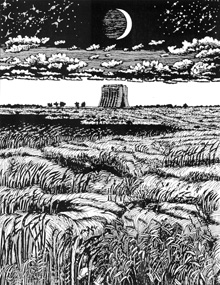 In the House-Senate Joint Committee hearing in 1967, it was recommended that the AEC take direct responsibility for all civil construction because of the magnitude of the project. This made my blood run cold, for it was bruited about in Washington that AEC buildings "did not have to be cheap, they just had to look cheap." John Erlewine, director of construction for the AEC, informed me that his division was ready to take on that responsibility. He listened sympathetically to my arguments to the contrary and then replied that if I could demonstrate responsibility, he would stay out of it. In the event, that's how it worked out. That implied a local office (for other reasons as well) and one of the AEC's greatest gifts to us was the Office Manager, the beloved Kennedy C. Brooks, or Casey as he was known to all. Casey, with a lifetime of construction experience, mostly with the AEC, had a beautifully light touch and he guided us through the labyrinthine procedures of the AEC.7 Support in great depth is what we got from the AEC in every respect -- they became more than a source of government funding, they became partners and comrades.
In the House-Senate Joint Committee hearing in 1967, it was recommended that the AEC take direct responsibility for all civil construction because of the magnitude of the project. This made my blood run cold, for it was bruited about in Washington that AEC buildings "did not have to be cheap, they just had to look cheap." John Erlewine, director of construction for the AEC, informed me that his division was ready to take on that responsibility. He listened sympathetically to my arguments to the contrary and then replied that if I could demonstrate responsibility, he would stay out of it. In the event, that's how it worked out. That implied a local office (for other reasons as well) and one of the AEC's greatest gifts to us was the Office Manager, the beloved Kennedy C. Brooks, or Casey as he was known to all. Casey, with a lifetime of construction experience, mostly with the AEC, had a beautifully light touch and he guided us through the labyrinthine procedures of the AEC.7 Support in great depth is what we got from the AEC in every respect -- they became more than a source of government funding, they became partners and comrades.
I have always felt that science, technology, and art are importantly connected, indeed, science and technology seem to many scholars to have grown out of art. In any case, in designing an accelerator I proceed very much as I do in making a sculpture. I felt that just as a theory is beautiful, so, too, is a scientific instrument -- or that it should be. The lines should be graceful, the volumes balanced. I hoped that the chain of accelerators, the experiments, too, and the utilities would all be strongly but simply expressed as objects of intrinsic beauty. Aesthetics is partly a matter of communication, and with so many people involved, I felt that everyone would appreciate the economy of good design and would keep their designs equally clean and understood.8
 The first product to appear almost at once at the Oak Brook offices was a full-size (in cross section) cardboard model of how big I thought the Main Ring tunnel should be, namely about 10 ft in diameter, and how large the magnets in it should be, about 25 in. by 14 in. This raised more than a few eyebrows, but that was how it was built. Models. I tried to have models built of every building and every component of the machine. It enabled me to visualize where drawings would confuse.9
The first product to appear almost at once at the Oak Brook offices was a full-size (in cross section) cardboard model of how big I thought the Main Ring tunnel should be, namely about 10 ft in diameter, and how large the magnets in it should be, about 25 in. by 14 in. This raised more than a few eyebrows, but that was how it was built. Models. I tried to have models built of every building and every component of the machine. It enabled me to visualize where drawings would confuse.9
Let me return to the excitement of designing the accelerator. Imagine the hysteria of those months at Oak Brook as we raced toward our deadline to have a credible design and cost estimate (a Schedule 44 for the cognescenti), in order to get funds to keep us on schedule. The DUSAF people were old pros, for they had traveled the same road at Berkeley during the preparation of the 200-BeV report. We just had to be Procrustean and have them change their designs to fit our financially limited beds. They had separate designers and cost estimators, but the accelerator part was more difficult because we, of course, did not have the technical resources of the Berkeley laboratory at all. In order to get reliable accelerator cost estimates, I called on my good friend Bill Brobeck. Bill, a master engineer, had been an exemplar of mine when I was a student in the old Radiation Laboratory. I tried to emulate him as much as possible in what I later did by way of design and engineering at Cornell where, with satisfaction, we had used the services of his company in the construction of the 10-GeV electron synchrotron. William M. Brobeck and Associates had a reputation for making high cost estimates, a practice that would counterbalance my own reputation for making low estimates. What we would do was to design various parts of the accelerator complex with our own few physicists and engineers and then Brobeck's people would make a cost estimate based on our design. DUSAF would make parallel cost estimates for the buildings and utilities. If the total estimate exceeded $250 million, we would go back and make inventions and more imaginative designs until our architectural and technical costs had come down to the level of our financial resources.
It wasn't easy, still it was a happy, triumphant group that turned in a $250 million design on October 1. I think I got decision-happy during that period, for there were thousands of decisions to be made. I learned to spew out decisions at a great rate: I would spout them off walking down the corridor as a Pope does benedictions. I came to understand that a poor decision was usually better than no decision at all, for if a necessary decision was not made, then the whole effort would just wallow -- and, after all, a bad decision could be corrected later on. Making decisions is heady stuff, it's the Director's raison d'etre, but I doubt that it is very good for a scientist's mind. I recall that in making important decisions, I would inform myself as much as possible before a meeting, i.e., get "psyched up," then listen as carefully as I could to the pros and cons, then rear back and deliver the goods -- usually from my subconscious. As I would walk away from such a session, I could feel the knowledge oozing out of me. Ten minutes later, confronting a new problem, I could not remember the earlier problem nor the decision. I seemed to have become a decision machine, far different from the reflective scholar who had come from Cornell University.10
It was not roses, roses, all the way. Tragedy began to strike as our numbers grew -- disease, even death. Nowhere in the annals of physics are such things mentioned, nor had my previous experience prepared me to cope with them. Yet coping was part of the job. I soon found that Tim Toohig, a cracking good physicist at the Lab, as well as a Jesuit priest, would appear on such occasions full of compassionate sympathy and understanding. Despite a difference in our religious beliefs, we became close friends and the difference narrowed as my respect for Tim grew. He became the spiritual counsel for the project.
There are so many stories to tell about the early days: getting access to the site; fighting for adequate funding; building the Linac, the Booster,11 the Main Ring,12 and the experimental areas;13 extracting the protons and switching them to the experimental areas;14 getting the whole complex to work at all and then to work reliably and with high enough proton intensity. Appendix A [see the 1987 Fermilab Annual Report, 187-90] gives an optimistic picture of the project as presented in my testimony of March of 1971 before the House-Senate Joint Committee on Atomic Energy. However, just after that report was given, all hell broke loose; it seemed that whatever could fail, did fail. But these stories are not for the telling here. Perhaps the illustrations will speak where words and memories now fail. More frustrating is that I have not addressed the major theme, indeed the only theme of the project, Physics, the planning of which started in the times covered here.
In retrospect, I suppose, my most serious problems had been with my colleagues. For exemplary reasons they felt impelled to do the best job of which they were capable and to minimize the probability of failure. I, on the other hand, was asking them to work at the edge of failure in order to save time and money, hoping to correct our mistakes as they arose. In many cases this understandably led to a real conflict, and to resolve the conflict, and in order to stay within budget and on schedule, I found it necessary to be firm, sometimes dictatorial. But that was exactly contrary to my own sense of how a good scientific laboratory should operate. Thus, my success as Director would hinge on how fast my strong-man regime would "wither," how soon I would become superfluous.
"I was never so active a sculptor as I was at Fermilab." The title translates as "Water to the Ropes." In 1586, Pope Sixtus V decided to move a 92 ft, 240ton obelisk 275 yards to the square in front of St. Peter's Cathedral in Rome. The architect, Domenico Fontana, was given supervision of the project. Fontana had calculated the exact thickness and length of the ropes needed to lower and then lift the monument. Each coil of rope was wound around a capstan sunk in the ground. Nine hundred men and 74 horses labored to move the structure. At one point, the ropes began slacking due to the hot, dry weather. In spite of an edict forbidding the onlookers to speak on pain of death, a bystander cried out "Water to the ropes!" thereby saving the project.
Originally I had hoped to return to the scholarly life at Cornell in five years, the duration of my leave. That, of course, was naive, but by the end of.eight years I had indeed become superfluous, for a wonderfully competent group of colleagues had taken over all phases of the operation of the Lab. My obsession had become the TEVATRON, but when the funds to operate the Lab had become patently inadequate, and when the funds for the TEVATRON had essentially dried up, it was time for me to leave, time for a younger director, time for Leon Lederman to take over. Leon managed to turn that dismal prospect around and under his regime the Lab has flourished.
Remembrance of things past; these inchoate memories float into and out of my consciousness like isolated clouds on a summer day. Perhaps, even if only partial, they may give some of the flavor of starting the Laboratory. Still to be told is the major story, a story of high adventure, hard work, occasional success, occasional failure, and always soaring spirits. To find out how it all turned out, tune in on the thirtieth anniversary.
Goethals was once asked what was the most important factor in building the Panama Canal. "It was the pride everyone felt in the work," he replied.
"But if the while I think on thee, dear friend
All losses are restored, and sorrows end"
1 I cannot make this a recital of names, nor can I ignore those colleagues who have randomly floated in and out of my remembrance. I propose to put nearly all of the remaining references to people in footnotes, thus the early administration consisted of Stan Livingston and Tom Collins as associate directors, Don Getz as Assistant Director, and Frank Cole as Assistant Director for Information. Don Getz, a hero of those days, knows most about what actually happened and has written an unpublished memoir in 1977 that captures the spirit of those early times. Frank Cole was in charge of putting out the NAL Monthly Report, which is still the definitive source of what happened and when. [back]
2 I take pride in being a descendent of John G. Fee, an Abolitionist preacher who founded Berea College for blacks and whites in pre-Civil War Kentucky. It was a family obligation to be involved in the Civil Rights Movement of the sixties, and becoming Director of Fermilab offered an opportunity for me, as well as for my comrades, to do something other than just talk. It was Kennard Williams, born in Chicago's inner city, who was our "godsend" in making the Laboratory effective in this respect. Ned Goldwasser bore the administrative responsibility and he has told the story in Bulletin of the Atomic Scientists, (Vol. XXV, No. 8, October 1969, pp. 7-10; see also: Science, [1185, June 1970]) of how we helped with open housing, with training and hiring programs, and with the use of minority businesses. I am still proud of our policy statement: "In any conflict between technical expediency and human rights, we shall stand firmly on the side of human rights" -- and we did. [back]
3 That was usually Cynthia Sazama, the first permanent secretary, who is still at Fermilab. A crucial concern for any director is his office support. In that matter I was exceedingly fortunate. Rose Bethe was the first secretary for the pre-Lab phase at Cornell. Priscilla Duffield, whom I had known first as Ernest Lawrence's secretary, then at Los Alamos as Robert Oppenheimer's secretary, worked with me as secretary (really as an Assistant Director, but she insisted on the title "secretary"), from late 1967. When Priscilla left, it was my great fortune to have Judy Ward (now Schramm) show up. Then there was a host on the second floor of the Central Lab: Jean Plese (now Lemke), Jackie Gifford (now Coleman), Doris Ferrell (now Bart), Anne Burwell, Barbara Rozic (now Kristen), and Helen Peterson, to mention a few. Not typical is the irrepressible Sammy Rumple, who helped organize the Riding Club and who moved from the Travel Office to the Users Center, went on to become a technician, and then left to found her own business for technical support for the Lab. [back]
4 Don Young, as well as several other physicists from the MURA project in Madison, Wisconsin, were the first to join the Laboratory. Phil Livdahl came from Argonne National Laboratory to join them. The group has been in the thick of things at the Lab ever since.
One of my policies at Fermilab, of which I am most proud and for which I was roundly criticized, was to move people in and out of various responsibilities at roughly yearly intervals (I disliked the "empires" which just naturally had grown up at other laboratories). Phil Livdahl exemplifies this. After the Linac was finished he moved on to help direct the commissioning of the Main Ring, became head of Accelerator Division and played an important role in the TEVATRON project, became Acting Director of the project, and finally Deputy Director. He retired in 1987 to devote his full energies to the Loma Linda medical accelerator. Paul Reardon went through similar changes: Head of the Booster, Business Manager, Head of the Accelerator Division, and exceedingly important in the development of the TEVATRON magnets. Indeed, a whole generation of similar physicists at the Laboratory became superb administrators in that game of musical chairs: Rich Orr, Dick Lundy, John Peoples, Bill Fowler, Helen Edwards, Russ Huson, Drasko Jovanovic, and many, many others. Then there was the host of anonymous physicists, engineers, and technicians performing prodigies of construction. Ryuji Yamada was typical; he worked devotedly and with great effort on nearly every aspect of the accelerator. [back]
5 Tom Collins came to us from the Harvard-MIT electron synchrotron laboratory. Tom had been the physicist most responsible for designing and building the 8-GeV synchrotron at Harvard and had made all sorts of accelerator inventions. The one that affected us most was to provide long straight sections in a strong focusing lattice; we had eight in our Main Ring. In addition to the arcane features of synchrotrons, Tom has an exceedingly good understanding of the nitty-gritty of accelerators: the utilities, and power supplies, and vacuum, etc., where most of the money would be spent. Tom, as Associate Director for Accelerators, was not only of importance in the design and construction of the Main Ring, but he was also close to me in all architectural matters. He ran a once-a-week meeting at which all architectural questions were discussed and at which most of the vital decisions about building schedules, etc., were made. I sometimes think that Tom's lifeblood flows through the magnets of the synchrotrons. He still is going just as strong with the TEVATRON -- a true Fermilab hero. [back]
6 We did not have a construction division in the Laboratory as did most labs. Instead, I made Parke Rohrer the Fermilab Associate Director for Construction, responsible to me. Parke is an exceptionally gifted person who could, and did, serve both DUSAF and Fermilab. If we moved rapidly and produced workable and attractive structures, it was because Parke Rohrer and his associates cared so much -- and indeed we had all sorts of people at the lab just like him. [back]
7 The people in Casey's office, from Fred Mattmueller to Minerva Sanders, his secretary, were also sympatico and models of efficiency. Casey's successor, Andy Mravca, performed bureaucratic and technical marvels. He worked so closely with our people that he sometimes knew more than we did about our plans. He boasted that he would have things lined up in Washington so that not more than one day, rather than three months, would be required to obtain the necessary AEC approvals -- he invariably came through in just that way -- and still does! [back]
8 Angela Gonzales, a draftsman at Cornell and a talented painter, had worked closely with me during the design of the Cornell synchrotron. She understood well what I was trying to get at, and was useful in her criticisms of the balance of my lines and forms. I was delighted when she agreed to come to the project, for she embodied to a degree what I wanted with regard to the aesthetics of the project. Her influence can be seen everywhere at the Lab, from the colors and forms of the buildings and accelerator to the highly original drawings on the covers of reports and the illustrations within. The Auditorium lecture program and concert series, and the art exhibits on the mezzanine of the Central Lab Building, originally directed by Janice Roberts, were another manifestation at the Lab of the unity of art and science and the general culture. This may be an appropriate place to discuss wives. My wife, Jane, was enormously important to the Lab both socially and in initiating the lectures program. I felt, too, that my colleagues were blessed in the great wives who accompanied them to the Lab. Many had jobs in the Lab, but all contributed importantly to the social ambience. Indeed, NALWO was formed by them so they could be more effective in their endeavors. [back]
9 Jose Poces, who ran our superb Model Shop, contributed importantly to our architecture by his creative suggestions in the process of making the models. Even better, he would brook no nonsense from me, he was devastatingly honest, but very useful in his candid criticism. [back]
10 Teamwork is of the essence in the operation of a large laboratory, yet individualism and some tranquility were an absolute necessity for my sanity. Thus, at lunch time or late at night, I would find myself getting rid of my aggressions by hammering at a piece of marble -- take that, and that, and that! -- and doing what I did exactly as I wanted, no explanations, no committees. I was never so active a sculptor as I was at Fermilab. [back]
11 The Booster was largely under the leadership, first of Arie Van Steenbergen, then of Paul Reardon, and then of Roy Billinge and Helen Edwards. The latter two not only completed it, but brought it into successful operation. [back]
12 John DeWire, and then Frank Shoemaker, contributed seminally in the early months. Ernie Malamud took over from them when they returned to their universities. Ernie was typical of the Fermilab physicist: utterly dedicated and utterly tireless. He took on all the hard problems from civil rights to union disputes. His was a romantic idealism, and while he was doing everything else, he was also arranging a collaboration with the Russians to do the first experiment. Ernie has written an unpublished account, "Early History of the Main Ring," October 20, 1983, which is the most authoritative description of the Main Ring effort. Two really great engineers made significant contributions: Dick Cassel and Hank Hinterberger. Quentin Kerns came from UCB with almost complete plans for the radio-frequency cavities. Don Edwards and Lee Teng were the theoretical gurus of the Main Ring. [back]
13 Jim Sanford, a visitor from Brookhaven during our summer of design, plotted out an idea to have but one beam extraction point and but one long external proton beam from which secondary beams diverged. It was a good idea and he was so enthralled that he later returned to the Lab to become the major-domo for the beams and an associate director for program planning. The first summer study at Aspen in 1968 was exceedingly valuable in designing the experimental areas to correspond to the anticipated experiments. [back]
14 Al Maschke, head of our Beam Transfer Group, was one of the first physicists to come to the project. He is an exceedingly imaginative and competent physicist and many of his ideas were crucial to the success of the project. Most important was his concept of extracting the beam with an efficiency of 99% -- up 'til then, 60% was considered quite good. Al was something of a character, to put it mildly. He did not get along with everyone, but our relationship was excellent -- perhaps because I respected his physics so much. However, we disagreed just once, and it was serious because Al walked away angrily and did not come back. Helen Edwards filled the void he left. Years later we made up -- but it was a tragedy for me when he left. [back]
Thanks
Sue Grommes ● Adrienne Kolb ● Rocky Kolb ● Bruce Chrisman
John Peoples ● Robert R. Wilson ● Leon M. Lederman
S. Chandrasekhar ● Leonard Euler's Illustrator ● Angela Gonzales
Pablo Picasso ● East Indian Mythology ● 5th Century B.C. Athenian Vase
5th Century B.C. Greek Mythology ● Leonardo da Vinci
Painters and Potters ● Hans Bethe ● Fermilab Photography ● Al Johnson
John Keats ● Emily Dickinson ● Jean Lemke ● Marcel Proust ● Chocolate
Lillian Hoddeson ● William Shakespeare ● Albrecht Dürer
19th Century Illustration Depicting a Mechanical Universe
This publication was selected from the treasures of the Fermilab Archives.




